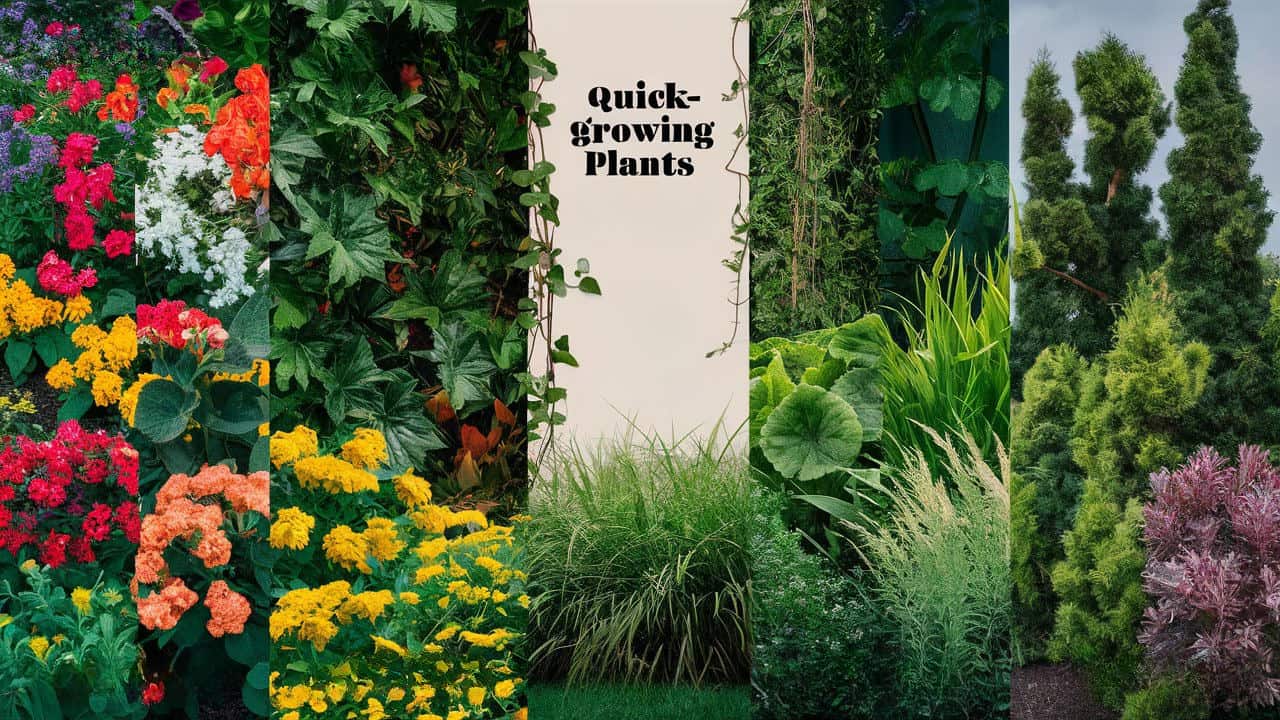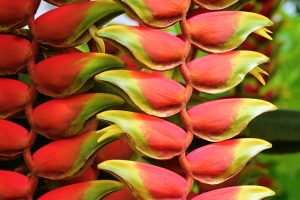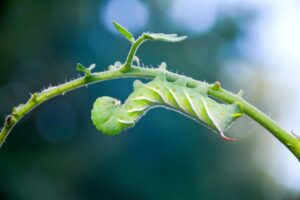In the world of gardening, there’s something to be said for instant gratification. While the slow, steady growth can be deeply rewarding, sometimes we gardeners crave a quicker payoff. In this blog post,we’ll introduce you to the best fast-growing plants that can transform a bare patch of soil into a vibrant, colorful display in a matter of weeks.
Annuals
Marigolds (Tagetes)
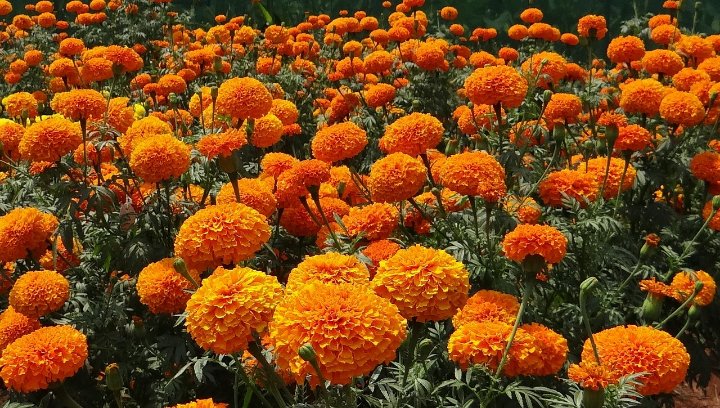
Marigolds are the quintessential fast-growing annual, beloved for their cheerful blooms and pungent, aromatic foliage. These sun-loving plants come in a wide range of sizes, from the towering ‘African’ varieties to the more compact ‘French’ types. What they all have in common is their ability to germinate and bloom in record time.
Sow marigold seeds directly in the garden after the last frost, and you can expect to see sprouts in as little as 5-7 days. Within 4-6 weeks, the plants will be covered in vibrant flowers in shades of yellow, orange, and red. Marigolds are also incredibly easy to grow, thriving in poor soil and hot, dry conditions that would send many other plants into a sulk.
Beyond their visual appeal, marigolds are also prized for their pest-repelling properties. The strong scent of the foliage is said to deter a variety of garden pests, making them a valuable companion plant for vegetables and other annuals.
Petunias (Petunia)
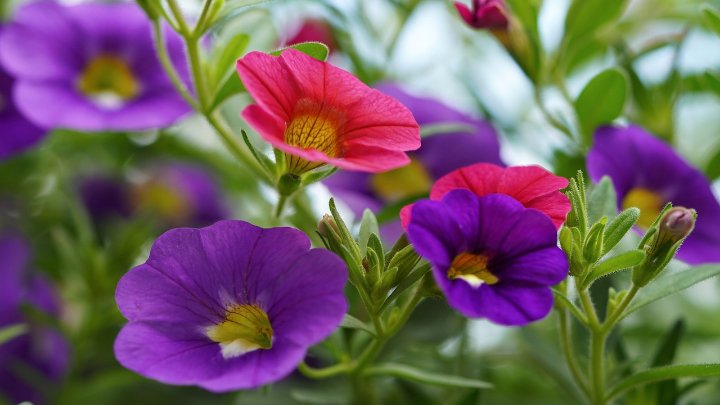
If you’re looking for a quick-growing annual that offers an endless array of colors and growth habits, look no further than petunias. These versatile plants come in everything from trailing ‘Surfinia’ types perfect for hanging baskets, to the compact, mounding ‘Grandiflora’ varieties ideal for beds and borders.
Petunias are another fast-germinating annual, with seeds sprouting in just 7-14 days. Once established, they’ll reward you with a continuous display of trumpet-shaped blooms from spring through fall. Deadhead spent flowers regularly to encourage more buds, and you’ll have a nonstop show of color all season long.
Petunias thrive in full sun and well-drained soil, making them a great choice for hot, sunny spots in the garden. They also come in a wide range of hues, from classic pink and purple to bold reds, oranges, and even black.
Nasturtiums (Tropaeolum)
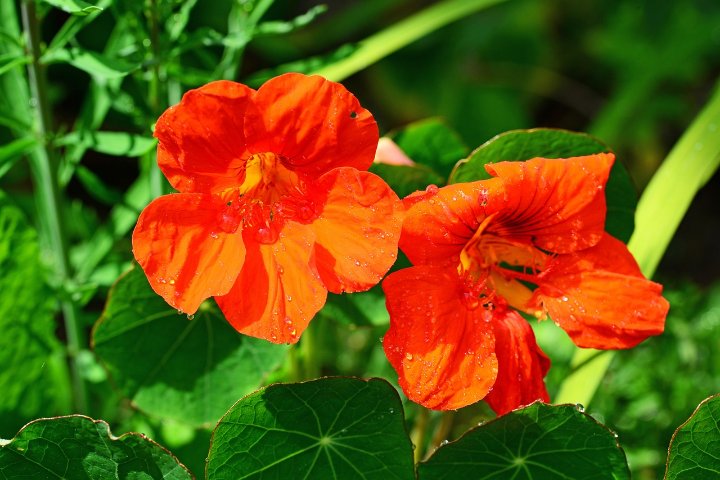
For a truly unique and eye-catching quick-growing annual, look no further than nasturtiums. These trailing or climbing plants are known for their vibrant, almost fluorescent blooms in shades of yellow, orange, and red. But that’s not all – the edible leaves and flowers are also a delicious addition to salads and other dishes.
Nasturtiums are one of the fastest-growing annuals, with seeds germinating in as little as 7-10 days. Once established, the plants will quickly sprawl or climb, depending on the variety. Trailing types make excellent ground covers or spill over the edges of containers, while climbing nasturtiums can be trained up trellises or fences.
Unlike many annuals, nasturtiums actually prefer poor, dry soil. In fact, they’ll often languish in overly rich or heavily amended garden beds. Give them full sun and well-drained soil, and they’ll reward you with a bountiful display of blooms and foliage all season long.
Sunflowers (Helianthus)

Few annuals capture the essence of summer quite like sunflowers. These towering, cheerful blooms are not only a visual delight, but they’re also incredibly easy to grow. Sunflowers are another quick-germinating annual, with seeds sprouting in just 7-10 days.
Once the seedlings emerge, sunflowers will rocket skyward, often reaching heights of 6 feet or more in a single growing season. Their large, vibrant flowers will follow suit, blooming in a rainbow of colors from classic sunny yellow to deep burgundy. Sunflowers are the perfect choice for adding height, drama, and a touch of whimsy to your garden beds and borders.
Beyond their aesthetic appeal, sunflowers are also a valuable resource for pollinators. Their nectar-rich blooms attract a wide variety of bees, butterflies, and other beneficial insects, making them a valuable addition to any wildlife-friendly garden.
Zinnias (Zinnia)
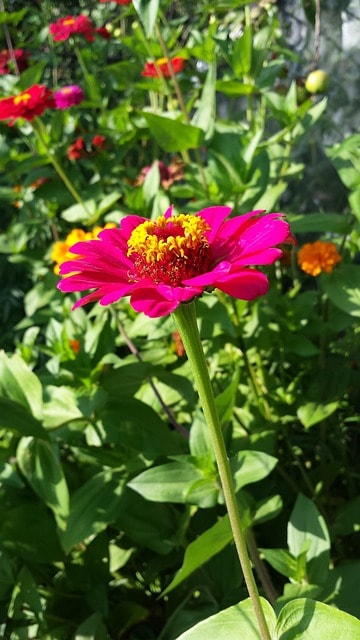
If you’re looking for an annual that delivers a nonstop display of color, zinnias are a must-grow. These bold, bright flowers come in a dazzling array of hues, from the classic reds and oranges to more unusual shades like lime green and deep purple.
Zinnias are another quick-growing annual, with seeds germinating in 7-12 days and plants reaching full bloom in just 4-6 weeks. Their sturdy, upright stems and long-lasting flowers make them an excellent choice for cutting gardens, as well as vibrant additions to beds and borders.
One of the best things about zinnias is their low-maintenance nature. They thrive in full sun and well-drained soil, and require little in the way of deadheading or pruning to keep them looking their best. Simply sow the seeds, water regularly, and enjoy the show.
Cosmos (Cosmos)
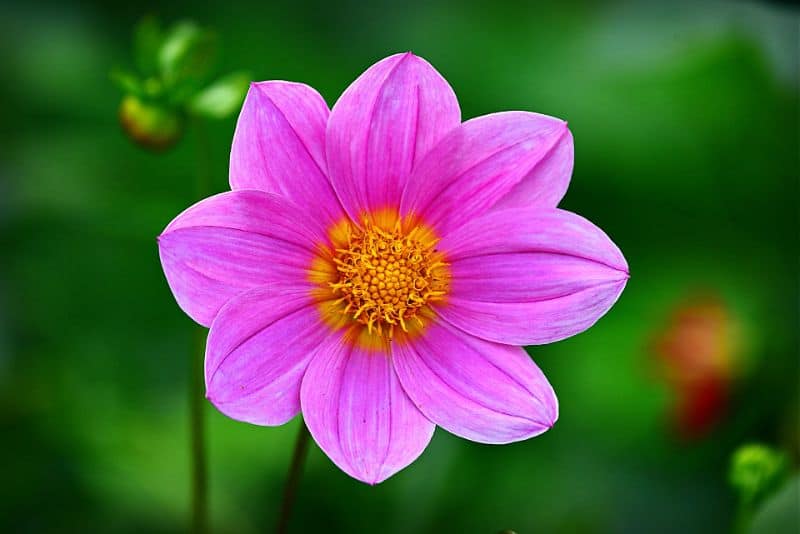
For a touch of airy, ethereal beauty in your garden, look no further than cosmos. These delicate-looking annuals may seem delicate, but they’re actually incredibly resilient and fast-growing. Cosmos seeds will sprout in just 7-14 days, and the plants will quickly reach heights of 2-4 feet.
The finely-textured, fern-like foliage of cosmos provides the perfect backdrop for their vibrant, daisy-like blooms. These flowers come in a range of hues, from the classic white and pink to bold shades of red, orange, and purple. Cosmos also self-sow readily, so once you have them established in your garden, you can enjoy their carefree presence year after year.
Like many of the other annuals we’ve explored, cosmos thrive in full sun and well-drained soil. They’re also incredibly drought-tolerant, making them a great choice for hot, dry areas of the garden. And as an added bonus, cosmos are a favorite of pollinators, attracting a wide variety of bees, butterflies, and other beneficial insects.
Perennials
While annuals are the go-to choice for quick-growing plants that deliver instant color and impact, there are also several perennials that can satisfy the gardener’s need for speed. In this next section, we’ll explore perennial powerhouses that can transform your garden in a single growing season.
Daylilies (Hemerocallis)
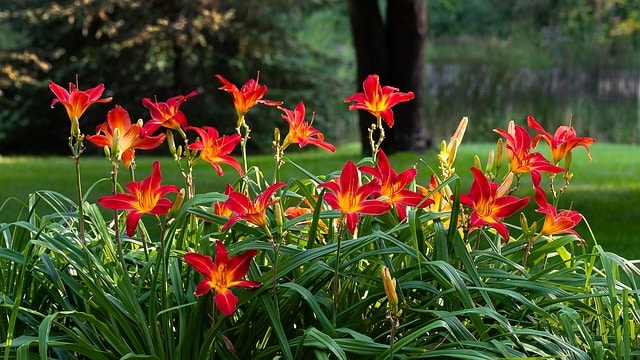
When it comes to fast-growing perennials, daylilies are true superstars. These resilient, low-maintenance plants are known for their ability to thrive in a wide range of growing conditions, from full sun to partial shade. But what really sets daylilies apart is their rapid growth and prolific blooming.
Daylily plants can be established from bare-root divisions or container-grown specimens, and they’ll quickly get to work putting down roots and sending up new foliage. Within the first growing season, you can expect to see a substantial increase in the size and vigor of your daylily plants.
And the blooms? Well, daylilies are true champions in that department as well. Each individual flower only lasts for a day, but the plants produce an abundance of buds that open in succession, providing weeks of colorful display. From the classic orange and yellow varieties to more exotic hues like deep red and purple, daylilies offer a diverse palette to choose from.
Hibiscus
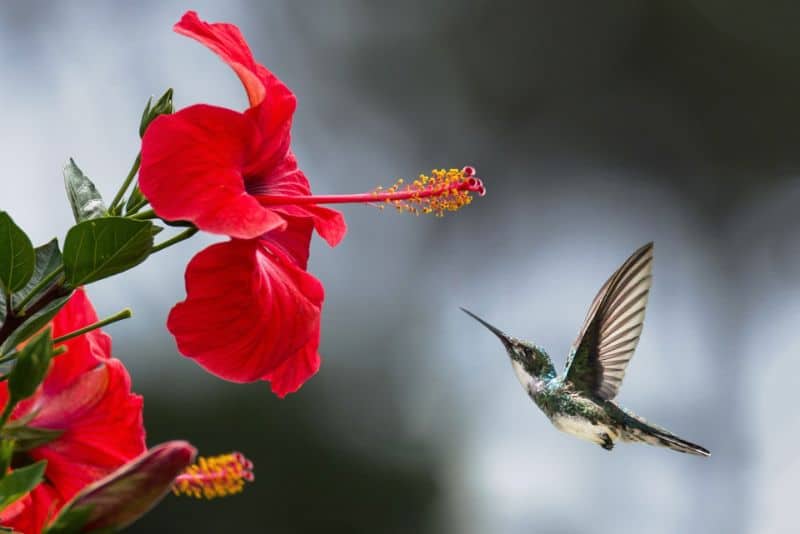
For a truly show-stopping perennial that can deliver big, bold blooms in a single season, look no further than hibiscus. These tropical-looking plants are known for their massive, dinner plate-sized flowers that come in a rainbow of colors, from vibrant red and pink to delicate white and lavender.
While hibiscus may have a reputation for being finicky, the truth is that they’re actually quite easy to grow – as long as you provide them with the right conditions. These sun-loving perennials thrive in hot, humid climates and well-drained, nutrient-rich soil. With the proper care, a young hibiscus plant can grow several feet tall and wide in just one growing season, rewarding you with a stunning floral display.
One of the best things about hibiscus is their versatility. They can be grown in the ground as part of a mixed border, or they can be cultivated in large containers and moved around the garden as needed. Just be sure to provide them with ample water and protection from strong winds, and you’ll be rewarded with a tropical oasis right in your own backyard.
Goat’s Beard (Aruncus dioicus)
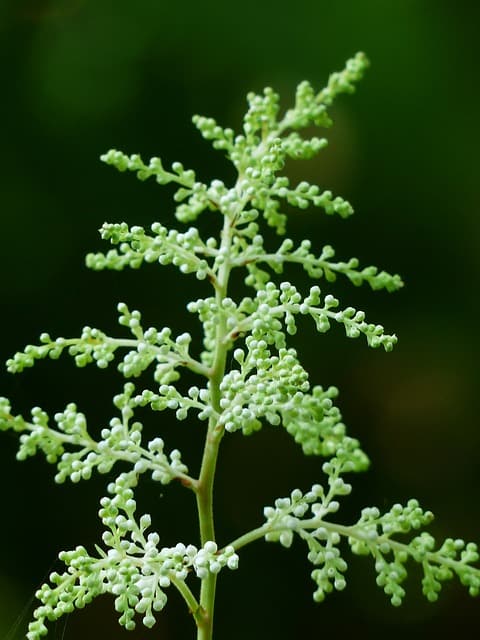
For a perennial that offers a unique, architectural presence in the garden, consider the stately Goat’s Beard. This native North American plant is known for its towering, plume-like flower spikes that can reach up to 6 feet tall in a single season.
Goat’s Beard is a true standout in the perennial world, with its fern-like foliage and dramatic, creamy-white blooms that appear in early summer. While it may take a year or two for the plant to become fully established, once it gets going, Goat’s Beard can quickly become a focal point in the garden.
One of the best things about Goat’s Beard is its versatility. It can thrive in a wide range of growing conditions, from full sun to partial shade, and it’s also quite drought-tolerant once it’s gotten its roots established. Plus, its tall, airy flower spikes make it an excellent choice for adding height and visual interest to mixed borders and woodland gardens.
False Indigo (Baptisia)

For a perennial that offers a unique, architectural presence in the garden, false indigo is a must-grow. Also known as wild indigo, this native North American plant is prized for its striking, lupine-like flower spikes that can reach up to 3 feet tall.
What sets false indigo apart is its ability to establish and grow quickly. While it may take a year or two for the plant to reach its full size, once it gets going, it can become a true focal point in the garden. The blue-green, clover-like foliage provides the perfect backdrop for the vibrant, pea-like blooms that appear in late spring and early summer.
False indigo is also incredibly versatile, thriving in a wide range of growing conditions. It’s equally at home in full sun or partial shade, and it’s also quite drought-tolerant once established. Plus, its tall, dramatic flower spikes make it an excellent choice for adding height and visual interest to mixed borders and prairie-style gardens.
Butterfly Bush
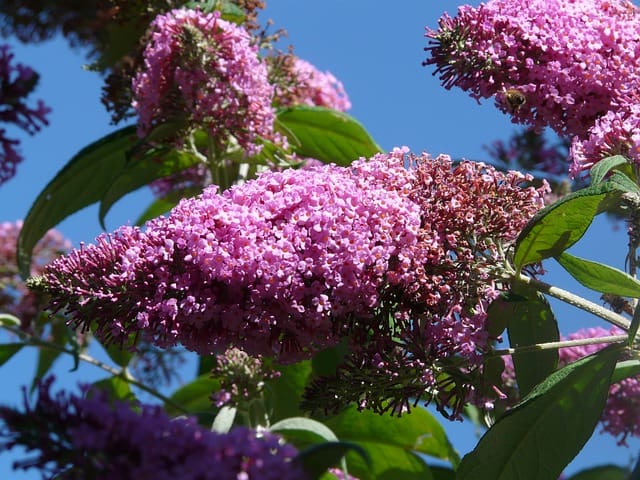
For a perennial that delivers a nonstop display of color and attracts a wealth of pollinators, look no further than the butterfly bush. These fast-growing, shrub-like plants are known for their arching, fragrant flower spikes that bloom from mid-summer through fall.
Butterfly bushes are true champions when it comes to rapid growth. In a single growing season, these plants can reach heights of 6 feet or more, with a similar spread. And the blooms? Well, they’re simply stunning, with vibrant clusters of tiny flowers in shades of purple, pink, white, and even yellow.
But the real draw of butterfly bushes is their ability to attract a wide variety of pollinators. As their name suggests, these plants are a magnet for butterflies, as well as hummingbirds, bees, and other beneficial insects. Planting a butterfly bush or two in your garden is an easy way to create a haven for these important creatures.
Like many of the other perennials we’ve explored, butterfly bushes thrive in full sun and well-drained soil. They’re also quite drought-tolerant, making them a great choice for hot, dry areas of the garden. And with their long bloom season and easy-care nature, they’re a perennial that’s sure to delight gardeners of all skill levels.
Vines
Sweet Pea (Lathyrus odoratus)
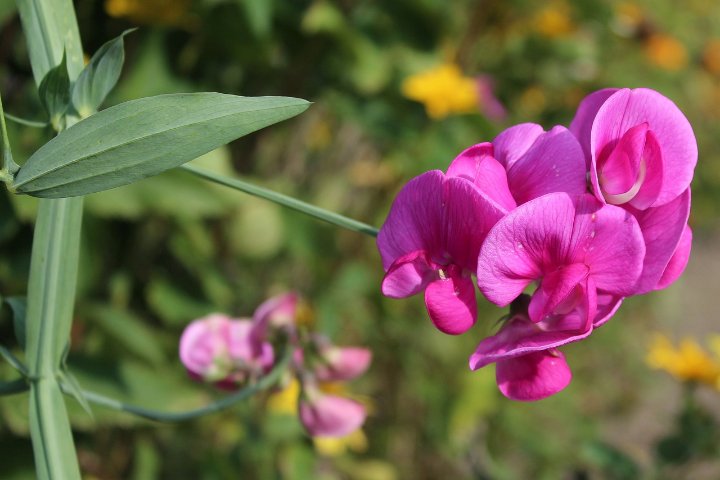
These charming, old-fashioned flowers are known for their delicate, butterfly-like blooms that come in a rainbow of colors, from classic pastels to bold, jewel-toned hues. What sets sweet peas apart is their rapid growth and prolific flowering.
These cool-weather annuals can be sown directly in the ground in early spring, and they’ll quickly sprout and begin climbing their way up trellises, fences, or other vertical supports.
Within just 8-12 weeks, you can expect to see the first flush of fragrant blooms, which will continue to appear in succession throughout the growing season.
Beyond their visual appeal, sweet peas are also a valuable resource for pollinators. Their nectar-rich flowers attract a wide variety of bees, butterflies, and other beneficial insects, making them a welcome addition to any wildlife-friendly garden.
Morning Glory (Ipomoea tricolor)

Morning glories are another quick-growing option, with seeds that can germinate in as little as 7-10 days. Once the vines get established, they’ll rapidly climb and spread, reaching heights of 10-15 feet in a single growing season. And the flowers? Well, they’re simply stunning, with a diverse palette of hues ranging from classic blue and purple to more unusual shades like pink, white, and even red.
One of the best things about morning glories is their versatility. They can be grown in the ground as part of a mixed border, or they can be cultivated in containers and trained up a trellis or other vertical support. Just be sure to provide them with full sun and well-drained soil, and you’ll be rewarded with a stunning, fast-growing display.
Scarlet Runner Bean (Phaseolus coccineus)
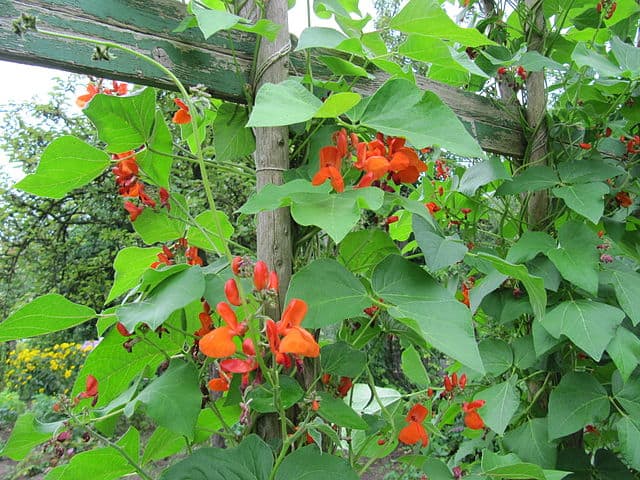
These fast-growing, climbing plants are known for their vibrant, scarlet-red flowers that bloom in abundance throughout the growing season.
But the real draw of scarlet runner beans is their ability to produce a bountiful harvest of edible pods. These beans are a favorite among gardeners for their crisp, flavorful texture and their ability to thrive in a wide range of growing conditions.
Like the other vines we’ve explored, scarlet runner beans are incredibly fast-growing, with seeds that can germinate in as little as 7-10 days. Once the vines get established, they’ll quickly climb up trellises, fences, or other vertical supports, reaching heights of 10-15 feet in a single season.
Beyond their practical benefits, scarlet runner beans also offer a stunning visual display. Their vibrant, scarlet-red flowers are a true showstopper, attracting a wealth of pollinators to the garden. And the edible pods, which can be harvested throughout the growing season, add an extra layer of utility to these versatile plants.
Wisteria (Wisteria)
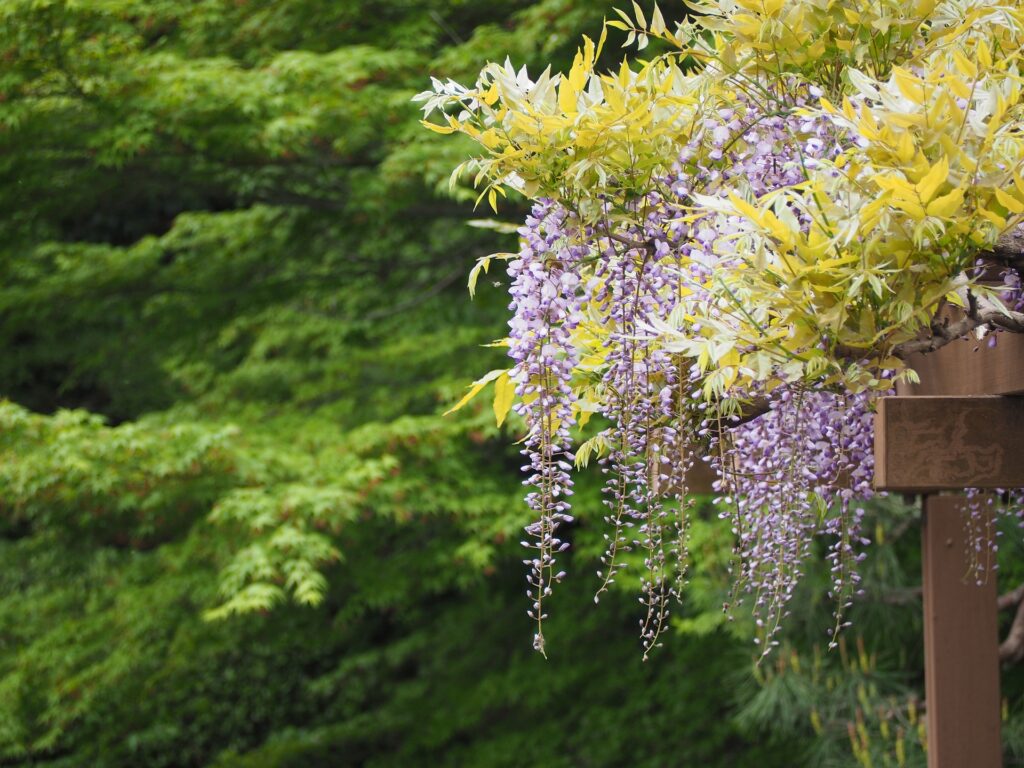
While wisteria may have a reputation for being a bit of a slow starter, once they get established, they can grow at an impressive rate. In a single growing season, a young wisteria plant can climb up to 30 feet, covering trellises, arbors, and other vertical structures with its lush, trailing foliage and fragrant flowers.
One of the best things about wisteria is its versatility. These vines can be trained to grow as freestanding shrubs, or they can be trained to climb up walls, fences, or other structures. And with their long bloom season, they provide a stunning focal point in the garden from late spring through early summer.
Trumpet Vine

Trumpet vines are true champions when it comes to rapid growth. In a single growing season, these plants can climb up to 40 feet, quickly covering trellises, arbors, and other vertical structures with their lush, green foliage and eye-catching blooms.
Beyond their visual appeal, trumpet vines are also a valuable resource for pollinators. Their nectar-rich flowers attract a wide variety of hummingbirds, butterflies, and other beneficial insects, making them a welcome addition to any wildlife-friendly garden.
Clematis (Clematis)
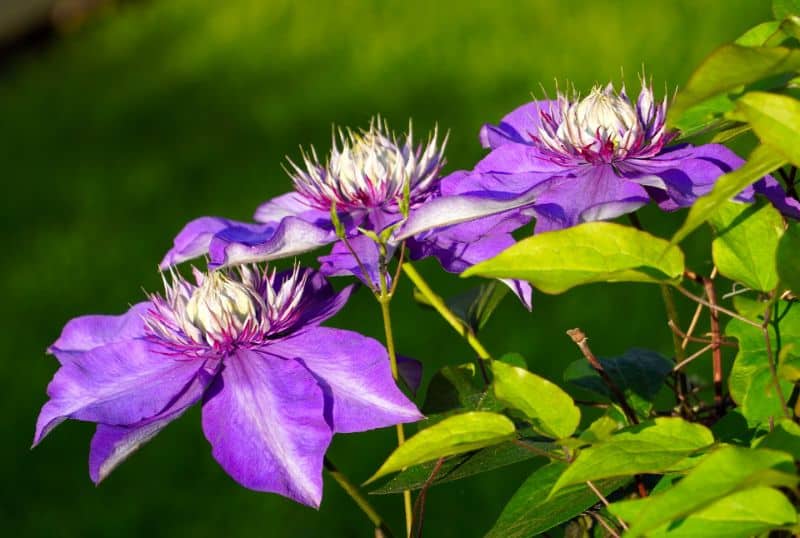
For a vine that offers a diverse array of bloom shapes and colors, clematis is a true standout. These fast-growing, woody vines are known for their large, showy flowers that come in a range of hues, from classic white and purple to more unusual shades like pink, red, and even blue.
One of the best things about clematis is their versatility. These vines can be trained to climb up trellises, fences, or other vertical structures, or they can be allowed to sprawl along the ground as ground covers. And with their long bloom season, they provide a stunning display of color from late spring through early fall.
Hops (Humulus lupulus)
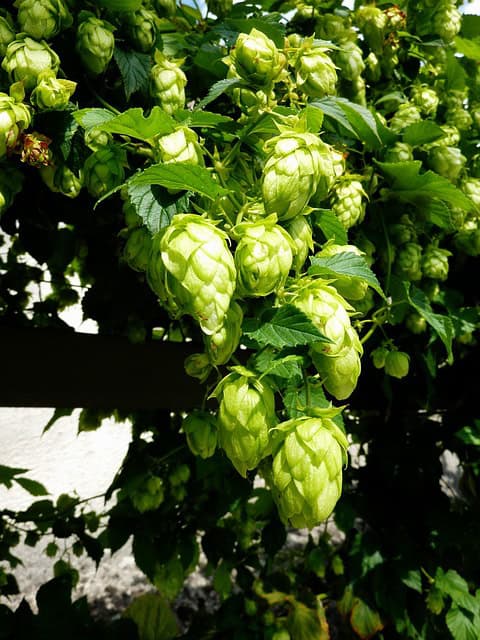
For a vine that offers both ornamental and practical appeal, hops are a true all-star. These fast-growing, climbing plants are known for their distinctive, cone-shaped flowers that are prized for their use in brewing beer.
But beyond their practical benefits, hops also offer a stunning visual display. In a single growing season, these vines can climb up to 20 feet, quickly covering trellises, arbors, and other vertical structures with their lush, green foliage and striking, golden-yellow flowers.
Hops are also a valuable resource for pollinators, attracting a wide variety of bees, butterflies, and other beneficial insects to the garden. And with their ability to thrive in a wide range of growing conditions, they’re a great choice for gardeners looking to add a touch of vertical interest and utility to their outdoor spaces.
Ornamental Grasses
Purple Fountain Grass (Pennisetum setaceum)

What sets purple fountain grass apart is its ability to establish and grow quickly. In a single growing season, these plants can reach heights of 3-4 feet, with a similar spread. And the best part? The foliage and flower plumes maintain their vivid color throughout the growing season, providing a stunning focal point in the garden.
Beyond their visual appeal, purple fountain grasses are also incredibly versatile. They can be used as standalone specimens, incorporated into mixed borders, or even grown in containers. And with their tolerance for a wide range of growing conditions, they’re a great choice for gardeners of all skill levels.
Switch Grass (Panicum)
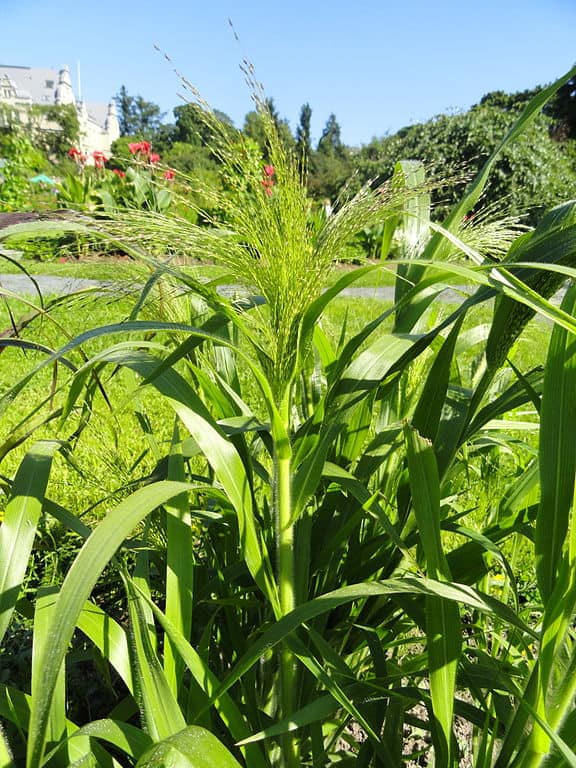
One of the best things about switch grass is its ability to thrive in a wide range of growing conditions. These plants can tolerate full sun, partial shade, and even drier soils, making them a great choice for a variety of garden settings.
In a single growing season, switch grass can reach heights of 3-5 feet, with a similar spread. And as the weather cools, the foliage takes on a stunning array of autumnal hues, ranging from golden yellow to deep burgundy.
Feather Reed Grass (Calamagrostis)
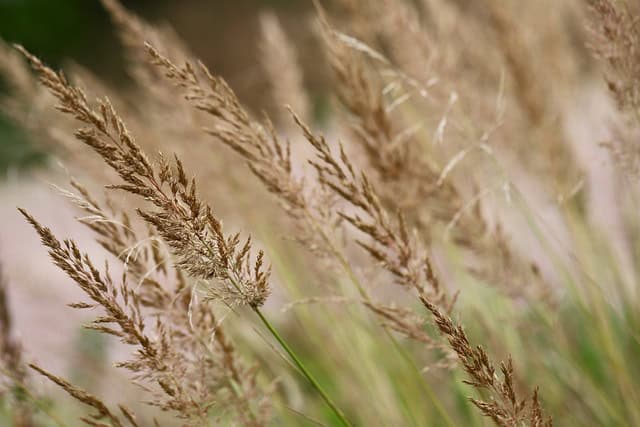
These fast-growing, upright plants are known for their tall, feathery flower plumes that appear in late spring and early summer. What sets feather reed grass apart is its ability to provide a striking vertical accent in the garden. In a single growing season, these plants can reach heights of 4-5 feet, with a relatively narrow spread. And the flower plumes? Well, they’re simply stunning, with their delicate, feathery texture and vibrant, golden-brown hues.
Beyond their visual appeal, feather reed grasses are also incredibly versatile. They can be used as standalone specimens, incorporated into mixed borders, or even grown in containers. And with their tolerance for a wide range of growing conditions, they’re a great choice for gardeners of all skill levels.
Shrubs
Common Caragana (Caragana arborescens)
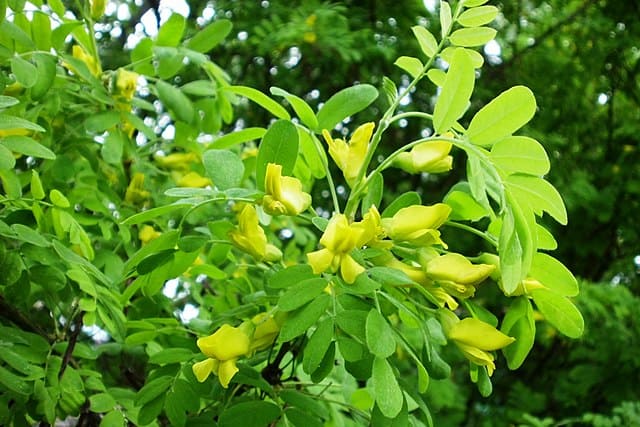
These fast-growing, deciduous plants are known for their delicate, pea-like foliage and cheerful, yellow flowers that appear in the spring. In a single growing season, common caragana can reach heights of 10-15 feet, with a similar spread. And as the plant matures, it develops a graceful, arching habit that adds a touch of elegance to any garden setting.
Beyond their visual appeal, common caragana are also incredibly hardy and adaptable. They can thrive in a wide range of soil types and growing conditions, making them a great choice for gardeners in more challenging climates. And with their ability to tolerate drought and poor soil, they’re a low-maintenance option that’s perfect for busy gardeners.
Red Osier Dogwood (Cornus sericea)
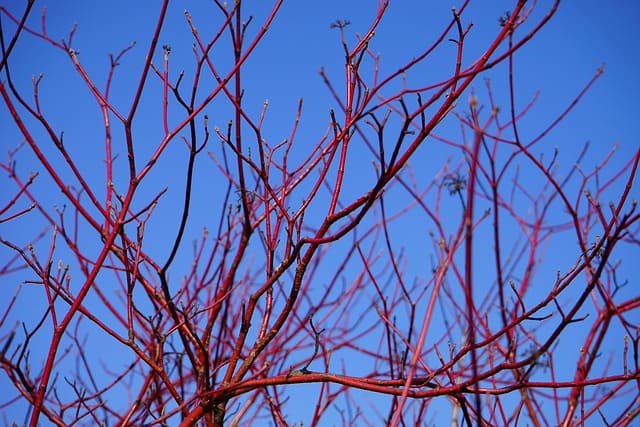
Red osier dogwood can reach heights of 6-10 feet, with a similar spread. And as the weather cools, the foliage takes on a stunning array of autumnal hues, ranging from deep red to brilliant orange.
Beyond their visual appeal, red osier dogwood are also a valuable resource for wildlife. Their berries are a favorite food source for a variety of birds and small mammals, making them a great choice for gardeners looking to attract more wildlife to their outdoor spaces.
Forsythia (Forsythia)
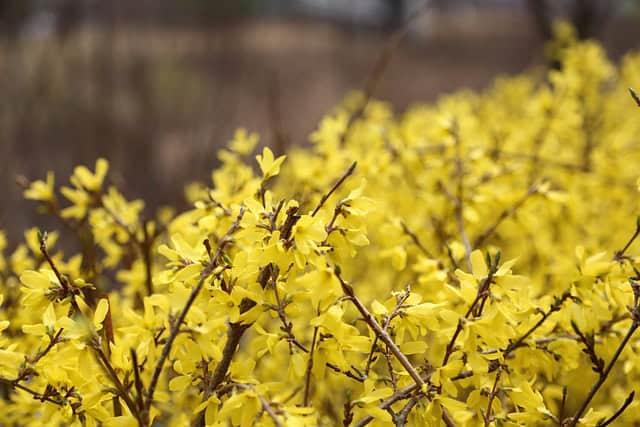
Forsythia delivers a burst of sunny, yellow blooms in early spring, forsythia is a must-grow. These fast-growing, deciduous plants are known for their profusion of bright, golden-yellow flowers that appear before the foliage emerges.
In a single growing season, forsythia can reach heights of 6-10 feet, with a similar spread. And as the plant matures, it develops a graceful, arching habit that adds a touch of elegance to any garden setting.
Beyond their visual appeal, forsythia are also incredibly hardy and adaptable. They can thrive in a wide range of soil types and growing conditions, making them a great choice for gardeners in more challenging climates. And with their ability to tolerate drought and poor soil, they’re a low-maintenance option that’s perfect for busy gardeners.
Smooth Hydrangea (Hydrangea arborescens)

Smooth Hydrangea offers a stunning display of large, showy blooms throughout the summer, smooth hydrangea is a true standout. These fast-growing, deciduous plants are known for their large, rounded flower clusters that range in color from pure white to soft pink.
In a single growing season, smooth hydrangea can reach heights of 3-5 feet, with a similar spread. And as the plant matures, it develops a lush, bushy habit that adds a touch of elegance to any garden setting.
Beyond their visual appeal, smooth hydrangea are also a valuable resource for pollinators. Their nectar-rich flowers attract a wide variety of bees, butterflies, and other beneficial insects, making them a great choice for gardeners looking to create a more wildlife-friendly outdoor space.
Trees
In this final section, we’ll dive into three remarkable tree species that can deliver a burst of height, texture, and visual interest in no time.
Trembling Aspen (Populus tremuloides)
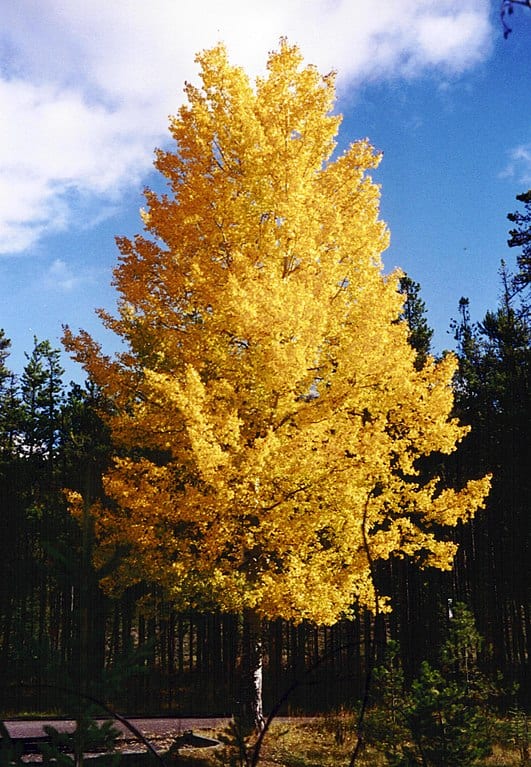
Trembling Aspen offers a captivating, shimmering display, trembling aspen is a true standout. These fast-growing, deciduous trees are known for their distinctive, heart-shaped leaves that tremble in the slightest breeze, creating a mesmerizing, dancing effect.
In a single growing season, trembling aspen can reach heights of 20-30 feet, with a similar spread. And as the tree matures, it develops a graceful, pyramidal shape that adds a touch of elegance to any landscape.
Beyond their visual appeal, trembling aspen are also incredibly hardy and adaptable. They can thrive in a wide range of soil types and growing conditions, making them a great choice for gardeners in more challenging climates. And with their ability to tolerate drought and poor soil, they’re a low-maintenance option that’s perfect for busy gardeners.
Paper Birch (Betula papyrifera)
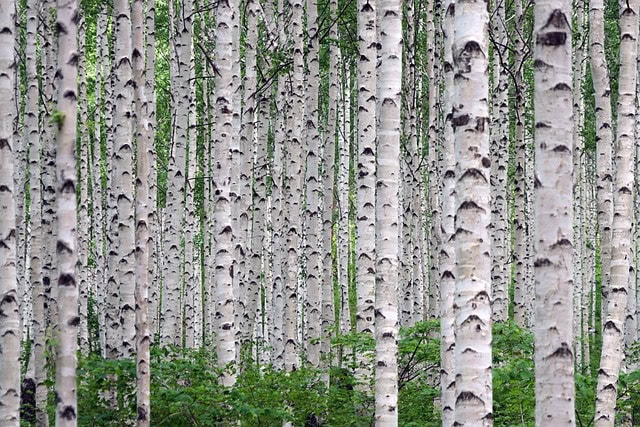
These fast-growing, deciduous trees are known for their distinctive, white bark that peels away in thin, papery layers, revealing a smooth, ivory surface underneath.
Paper birch trees can reach heights of 30-40 feet, with a similar spread. And as the tree matures, it develops a graceful, multi-trunked habit that adds a touch of natural elegance to any landscape.
Beyond their visual appeal, paper birch are also a valuable resource for wildlife. Their seeds are a favorite food source for a variety of birds, while their peeling bark provides nesting material and shelter for a range of small mammals and insects.
Amur Chokecherry (Prunus maackii)
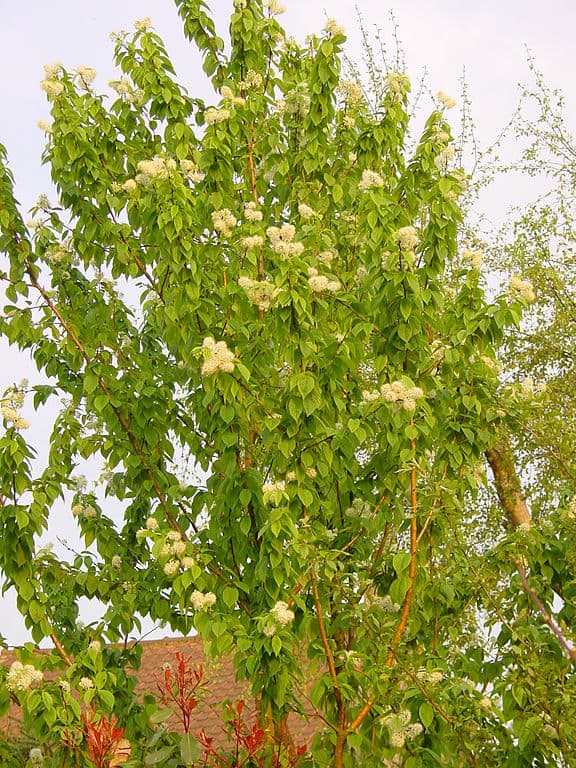
These fast-growing, deciduous trees are known for their clusters of fragrant, white flowers that appear in early spring, followed by lush, green foliage that transforms into a brilliant array of yellow, orange, and red hues in the fall.
Amur chokecherry trees can quickly reach heights of 20-30 feet, with a similar spread. And as the tree matures, it develops a rounded, multi-trunked habit that adds a touch of natural elegance to any landscape.
Beyond their visual appeal, Amur chokecherry are also a valuable resource for wildlife. Their small, dark-colored fruits are a favorite food source for a variety of birds and small mammals, making them a great choice for gardeners looking to attract more wildlife to their outdoor spaces.
Elm (Ulmus)
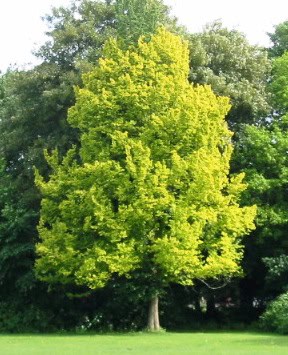
These fast-growing, deciduous trees are known for their distinctive, vase-shaped canopy and their ability to provide ample shade and shelter. Elm trees can reach heights of 40-60 feet, with a similar spread. And as the tree matures, it develops a graceful, arching habit that adds a touch of elegance to any landscape.
Beyond their visual appeal, elm trees are also incredibly hardy and adaptable. They can thrive in a wide range of soil types and growing conditions, making them a great choice for gardeners in more challenging climates. And with their ability to tolerate drought and poor soil, they’re a low-maintenance option that’s perfect for busy gardeners.
Amur Maple (Acer ginnala)
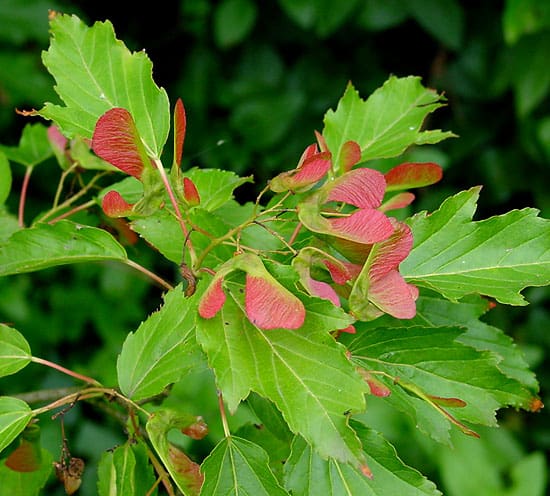
These fast-growing, deciduous trees are known for their delicate, lobed leaves that transform into a brilliant array of red, orange, and yellow hues as the weather cools.
Amur maple trees can reach heights of 15-25 feet, with a similar spread. And as the tree matures, it develops a rounded, multi-trunked habit that adds a touch of natural elegance to any landscape.
Beyond their visual appeal, Amur maple are also a valuable resource for wildlife. Their small, winged fruits are a favorite food source for a variety of birds and small mammals, making them a great choice for gardeners looking to attract more wildlife to their outdoor spaces.
Weeping Willow (Salix babylonica)
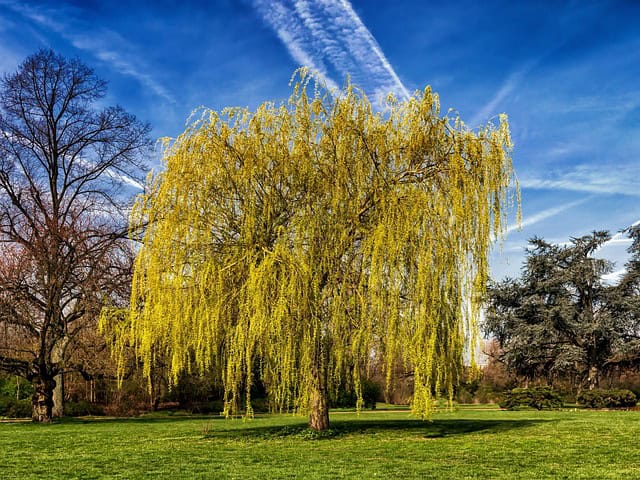
These fast-growing, deciduous trees are known for their long, pendulous branches that drape down to the ground, creating a stunning, natural canopy. Weeping willow can reach heights of 30-50 feet, with a similar spread. And as the tree matures, it develops a distinctive, weeping habit that adds a touch of elegance and movement to any landscape.
Beyond their visual appeal, weeping willow are also a valuable resource for wildlife. Their lush, green foliage provides shelter and nesting material for a variety of birds and small mammals, while their flexible branches can be used by pollinators as a resting spot.


